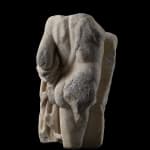Roman
A Roman marble torso of a warrior, circa 2nd century AD
Marble
Height: 31 cm
Further images
This powerful figure is probably from a sarcophagus relief depicting a battle. Carved in very high relief, it preserves the rear view of a muscular warrior depicted in heroic nudity...
This powerful figure is probably from a sarcophagus relief depicting a battle. Carved in very high relief, it preserves the rear view of a muscular warrior depicted in heroic nudity with his sword belt diagonally across his chest, and the drapery wrapped around his left arm and falling at his side. The figure is dynamically twisting to his left, revealing the defined musculature of his back and shoulders.
Condition
General surface wear and chipping throughout. Visible wear and discolouration particularly to the right buttock, left elbow and right shoulder.
Condition
General surface wear and chipping throughout. Visible wear and discolouration particularly to the right buttock, left elbow and right shoulder.
Provenance
Leif Hasle (1933-2016) Collection, Denmark, thought to have been acquired between the 1970s and 1990sLeif Hasle, the writer and poet, was born in Aarhus, Denmark in 1933, the son of the politician Henning Hasle. In 1940 the family moved to Copenhagen where Hasle lived for most of his life. Apart from his writing, he was a passionate and discerning art collector with many pieces from the Danish Golden Age. (1800-1850)









